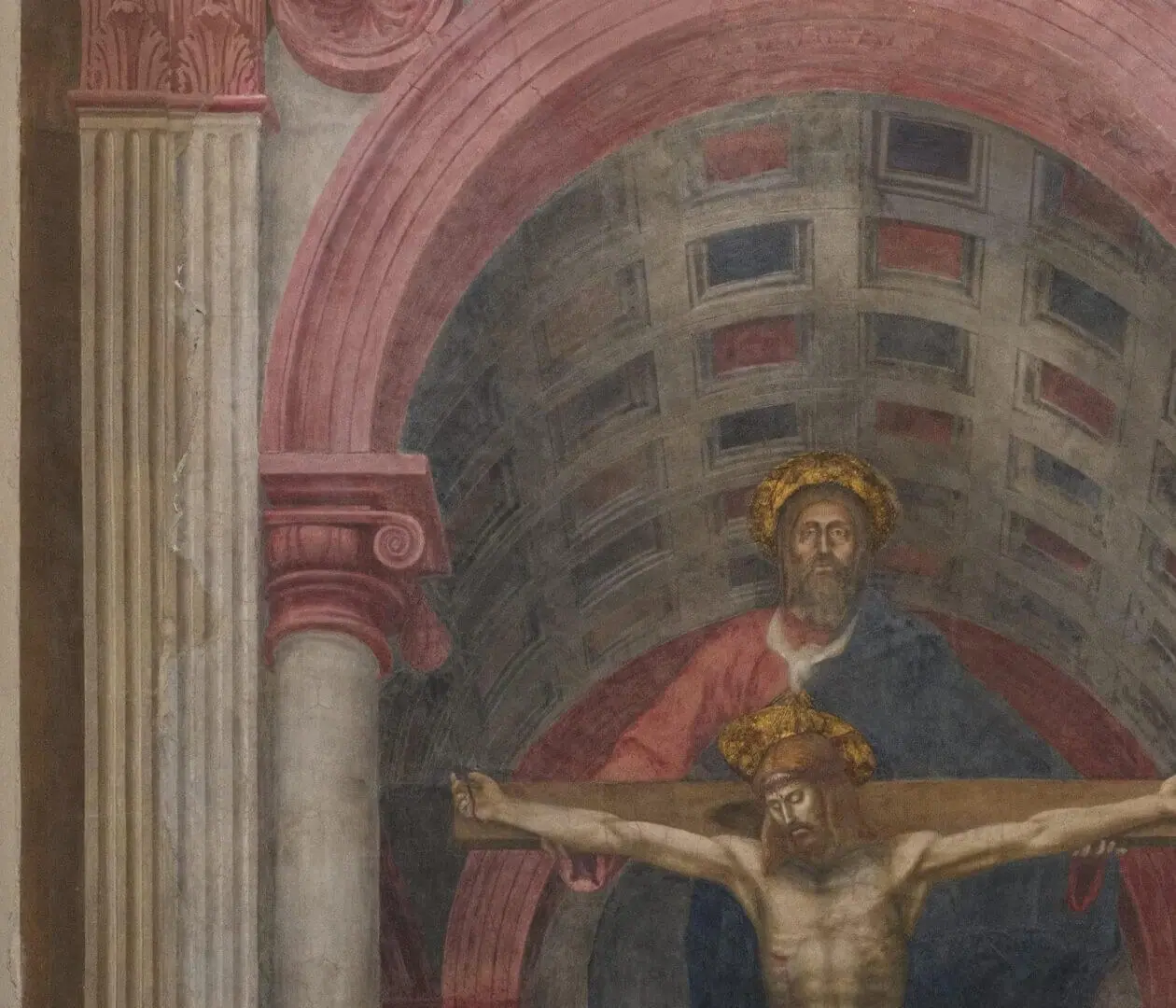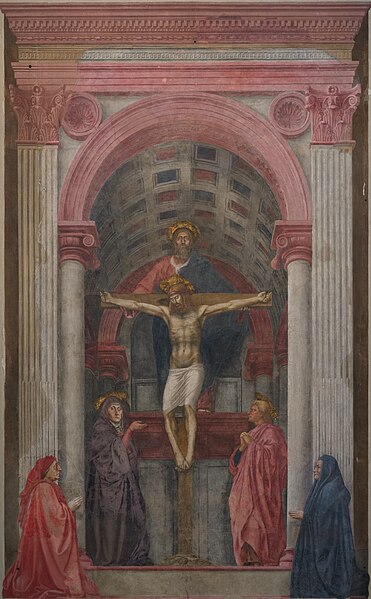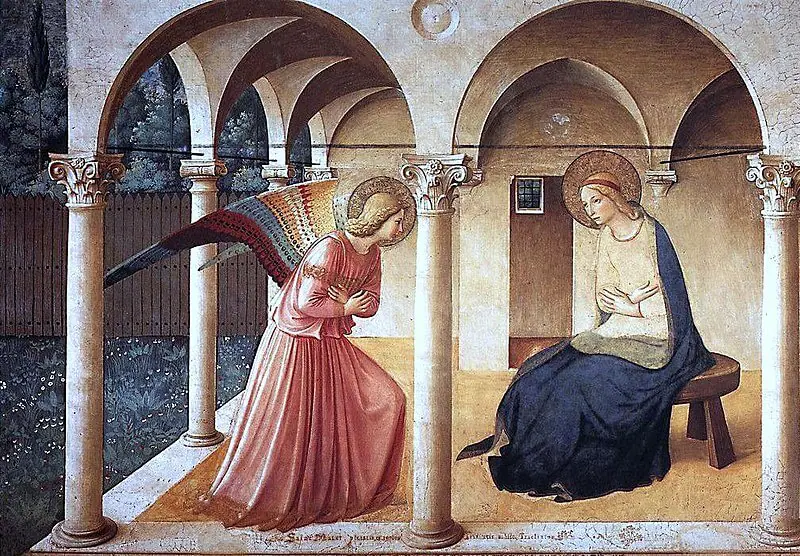Giotto di Bondone, Scenes from the Life of Saint Francis, Death and Ascension of St Francis (detail),
c. 1325, fresco, Bardi Chapel, Santa Croce, Florence
Anyone who has a history of art A-Level will likely tell you that the first stirrings of the Italian Renaissance were those of Giotto. Although this is not strictly true and the deep history of the Renaissance goes back until at least the 13th Century and Sienese painters like Cimabue, Giotto is a starting point for many. This is because he was one of the first prolific artists to eschew the gold ground technique and depict his subjects in naturalistic settings, painted in fresco. This work, at Santa Croce, is notable not only for the architectural space the figures inhabit, but for the rendering of the figures themselves. We are fully convinced of their solidity, that there is human mass beneath their robes. Furthermore, Giotto renders the foreshortening of the kneeing figures with real aplomb, all the more remarkable when painters like Uccello were still grappling with depicting this kind of anatomy well over 100 years later.
Masaccio, The Holy Trinity, with the Virgin and Saint John and donors,
c. 1425-27, fresco, Santa Maria Novella, Florence
If Giotto laid the foundations, then Masaccio can, with some qualification, be regarded the first master of the early Florentine Renaissance. The Trinity is found on the left aisle, about half-way down the church’s length and it is one of the earliest convincing applications of one-point perspective as depicted by architecture. Speaking of architecture, one of the most striking things about this fresco is that it is painted onto an unadorned wall – rather than a recessed chapel – therefore the painting behaves as a trompe-l’oeil of fictive, rather than real, spatial depth. Masaccio’s career was tragically short – he died in 1428 aged only 26. As a result, he left relatively few works behind him. His most complete and ambitious work is his fresco cycle at the Brancacci Chapel, Santa Maria del Carmine in the Oltrarno area of Florence.
Fra Angelico, The Annunciation,
1440-45, fresco, Convent of San Marco, Florence
The other frescoes on this list are all grand public commissions; the present work, on the other hand, is quite the opposite. This, along with many other similar works in the same building, was painted on the wall of a small monk’s cell at the Convent of San Marco. The purpose of this was to serve as a contemplative aid for prayer. The colours of these frescoes are pale and gentle, which not only mirror the whitewashed cell walls, but also have a calming and meditative effect. Part of this more earthy approach was the artist’s placement of the Annunciation in a contemporary architectural setting that the monks could understand and relate to their own lives. This is why the opening moments of the New Testament are here taking place in a Renaissance loggia.
Domenico Ghirlandaio, The Tornabuoni Chapel
1485-90, fresco, Santa Maria Novella, Florence
The Tornabuoni Chapel features one of the largest and most complete fresco cycles in the whole of the city, one that occupies the entirety of the principal chapel behind the altar at Santa Maria Novella. The frescoes were commissioned by Giovanni Tornabuoni, a Florentine merchant, and depict the lives of the Virgin and John the Baptist. This cycle is perhaps the moment that Florentine public art reaches its zenith, the frescoes being executed at the very moment the early Renaissance gives way to the high Renaissance. This is evident in the full evocation and revival of classical art. The Massacre of the Innocents was regarded as the finest fresco of the cycle by Giorgio Vasari, perhaps due to its elaborate Roman triumphal arch and because of the enormous dynamism of the figures which recall Hellenistic Greek sculpture. The Tornabuoni Chapel is significant also because it most likely provided the training ground for Ghirlandaio’s most famous pupil, the young Michelangelo.
Giorgio Vasari and Federico Zuccari, The Last Judgement,
1572-79, fresco, Cattedrale di Santa Maria del Fiore, Florence
The largest and latest fresco on this list is perhaps the most controversial entry too. Brunelleschi’s dome is certainly the most famous architectural achievement in the city, if not the whole Italian Renaissance. The dome was constructed between 1420-36 but, almost 150 years later, the inside of the dome was still blank, having been whitewashed. Grand Duke Cosimo I de’Medici took it upon himself to have the dome decorated and, after having discounted the idea of a mosaic, chose to employ the court painter and art historian Vasari to complete the enormous task. The Last Judgement was chosen as the subject, a choice presumably influenced by Michelangelo’s work of the same name in the Sistine Chapel, completed some 30 years earlier. The scheme shows the descent to Hell and the ascent to Heaven as concentric rings. In the end, Vasari only finished the upper, central rings before he died, leaving Zuccari to complete the commission to his designs. Zuccari’s work has since been criticised as being of poor quality, although this is not immediately apparent from the floor of the crossing. Despite this supposed weakness, the fresco is hugely impressive when viewed from the base of the arch, as part of the climb to the dome’s lantern. From here one can appreciate the huge foreshortenings necessary to make a painting on a curved surface legible from below. It also gives us a rather vertigo-inducing insight into the feat of engineering required to scaffold the dome before Vasari’s brush could touch the wet plaster.






